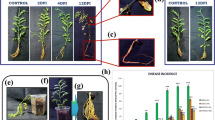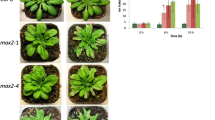Abstract
Fusarium oxysporum is a soilborne fungal pathogen that causes major economic losses by inducing necrosis and wilting symptoms in many crop plants. In this study, the interaction between F. oxysporum and the model plant Arabidopsis thaliana has been investigated to better understand the nature of host defences that are effective against the Fusarium wilt pathogen. The expression of salicylate- and jasmonate-responsive defence genes in F. oxysporum-challenged roots of A. thaliana plants as well as in the roots of plants whose leaves were treated with salicylate or jasmonate was analysed. Unexpectedly, genes (e.g. PR1, PDF1.2, and CHIB) encoding proteins with defensive functions or transcription factors (e.g. ERF1, AtERF2, AtERF4 and AtMYC2) known to positively or negatively regulate defences against F. oxysporum were not activated in F. oxysporum-inoculated roots. In contrast, the jasmonate-responsive defence gene PDF1.2 was induced in the leaves of plants whose roots were challenged with F. oxysporum, but the salicylate-responsive PR1 gene was not induced in the leaves of inoculated plants. Exogenous salicylic acid treatment prior to inoculation, however, activated PR1 and BGL2 defence gene expression in leaves and provided increased F. oxysporum resistance as evidenced by reduced foliar necrosis and plant death. Exogenous salicylic acid treatment of the foliar tissue did not activate defence gene expression in the roots of plants. This suggests that salicylate-dependent defences may function in foliar tissue to reduce the development of pathogen-induced wilting and necrosis. Despite the induction of defence gene expression in the leaves by jasmonate, this treatment did not lead to increased resistance to F. oxysporum. Overall, the results presented here suggest that the genetic manipulation of plant defence signalling pathways is a useful strategy to provide increased Fusarium wilt resistance.
Similar content being viewed by others
References
Anderson JP, Badruzsaufari E, Schenk PM, Manners JM, Desmond OJ, Ehlert C, Maclean DJ, Ebert PR, Kazan K (2004) Antagonistic interaction between abscisic acid and jasmonate-ethylene signalling pathways modulates defence gene expression and disease resistance in Arabidopsis. The Plant Cell 16, 3460–3479. doi: 10.1105/ tpc.104.025833
Anderson JP, Thatcher LF, Singh KB (2005) Plant defence responses: conservation between models and crops. Functional Plant Biology 32, 21–34. doi: 10.1071/FP04136
Benhamou N, Belanger RR (1998) Benzothiadiazole-mediated induced resistance to Fusarium oxysporum f. sp. radicis-lycopersici in tomato. Plant Physiology 118, 1203–1212. doi: 10.1104/ pp.118.4.1203
Berrocal-Lobo M, Molina A (2004) Ethylene response factor 1 mediates Arabidopsis resistance to the soilborne fungus Fusarium oxysporum. Molecular Plant-Microbe Interactions 17, 763–770.
Brown RL, Kazan K, McGrath KC, Maclean DJ, Manners JM (2003) A role for the GCC-box in jasmonate-mediated activation of the PDF1.2 gene of Arabidopsis. Plant Physiology 132, 1020–1032. doi: 10.1104/pp.102.017814
Campbell E, Schenk PM, Kazan K, Penninckx IAMA, Anderson JP, Maclean DJ, Cammue BP, Ebert PE, Manners JM (2003) Pathogen-responsive expression of an Arabidopsis ABC-transporter gene conferring resistance to the diterpenoid sclareol is regulated by multiple defense signaling pathways. Plant Physiology 133, 1272–1284. doi: 10.1104/pp.103.024182
Delessert C, Kazan K, Wilson IW, Van Der Straeten D, Manners J, Dennis ES, Dolferus R (2005) The transcription factor ATAF2 represses the expression of pathogenesis-related genes in Arabidopsis. The Plant Journal 43, 745–757. doi: 10.1111/j.1365-313X.2005.02488.x
Desmond OJ, Edgar CI, Manners JM, Maclean DJ, Schenk PM, Kazan K (2006) Methyl jasmonate induced gene expression inwheat delays symptom development by the crown rot pathogen Fusarium pseudograminearum. Physiological and Molecular Plant Pathology 67, 171–179. doi: 10.1016/j.pmpp.2005.12.007
Diener AC, Ausubel FM (2005) RESISTANCE TO FUSARIUM OXYSPORUM 1, a dominant Arabidopsis disease-resistance gene, is not race specific. Genetics 171, 305–321. doi: 10.1534/ genetics.105.042218
Dombrecht B, Kazan K, Manners JM (2006) Improved resistance to Fusarium wilt through genetic engineering of defence signalling pathways. In ‘Floriculture, ornamental and plant biotechnology. Vol. 3’. (Ed. JA Teixeira da Silva) pp. 388–398. (Global Science Books: London)
Dowd C, Wilson IW, McFadden H (2004) Gene expression profile changes in cotton root and hypocotyl tissues in response to infection with Fusarium oxysporum f. sp. vasinfectum. Molecular Plant-Microbe Interactions 17, 654–667.
Govrin EM, Levine A (2000) The hypersensitive response facilitates plant infection by the necrotrophic pathogen Botrytis cinerea. Current Biology 10, 751–757. doi: 10.1016/S0960-9822(00) 00560-1
Hegedus DD, Rimmer SR (2005) Sclerotinia sclerotiorum: when “to be or not to be” a pathogen? FEMS Microbiology Letters 251, 177–184. doi: 10.1016/j.femsle.2005.07.040
Hermanns M, Slusarenko AJ, Schlaich NL (2003) Organ-specificity in a plant disease is determined independently of R gene signaling. Molecular Plant-Microbe Interactions 16, 752–759.
Ito S, Eto T, Tanaka S, Yamauchi N, Takahara H, Ikeda T (2004) Tomatidine and lycotetraose, hydrolysis products of alpha-tomatine by Fusarium oxysporum tomatinase, suppress induced defense responses in tomato cells. FEBS Letters 571, 31–34. doi: 10.1016/j.febslet.2004.06.053
Kazan K (2006) Negative regulation of defence and stress genes by EAR-motif containing repressors. Trends in Plant Science 11, 109–112. doi: 10.1016/j.tplants.2006.01.004
Lim GTT, Wang G-P, Hemming MN, Basuki S, McGrath DJ, Carroll BJ, Jones DA (2006) Mapping the I-3 gene for resistance to fusarium wilt in tomato: application of a I-3 marker in tomato improvement and progress towards the cloning of I-3. Australasian Plant Pathology 35, 661–670.
Llorente F, Alonso-Blanco C, Sanchez-Rodriguez C, Jorda L, Molina A (2005) ERECTA receptor-like kinase and heterotrimeric G protein from Arabidopsis are required for resistance to the necrotrophic fungus Plectosphaerella cucumerina. The Plant Journal 43, 165–180. doi: 10.1111/j.1365-313X.2005. 02440.x
Lorenzo O, Piqueras R, Sanchez-Serrano JJ, Solano R (2003) ETHYLENE RESPONSE FACTOR1 integrates signals from ethylene and jasmonate pathways in plant defense. The Plant Cell 15, 165–178. doi: 10.1105/tpc.007468
Lorenzo O, Chico JM, Sanchez-Serrano JJ, Solano R (2004) JASMONATE-INSENSITIVE1 encodes aMYC transcription factor essential to discriminate between different jasmonate-regulated defence responses in Arabidopsis. The Plant Cell 16, 1938–1950. doi: 10.1105/tpc.022319
McGrath KC, Dombrecht B, Manners JM, Schenk PM, Edgar CI, Maclean DJ, Scheible WR, Udvardi MK, Kazan K (2005) Repressorand activator-type ethylene response factors functioning in jasmonate signalling and disease resistance identified via a genome-wide screen of Arabidopsis transcription factor gene expression. Plant Physiology 139, 949–959. doi: 10.1104/pp.105.068544
Mes JJ, van Doorn AA, Wijbrandi J, Simons G, Cornelissen BJ, Haring MA (2000) Expression of the Fusarium resistance gene I-2 colocalizes with the site of fungal containment. The Plant Journal 23, 183–193. doi: 10.1046/j.1365-313x.2000.00765.x
Nickstadt A, Thomma BPHJ, Feussner I, Kangasjärvi J, Zeier J, Loeffler C, Scheel D, Berger S (2004) The jasmonate-insensitive mutant jin1 shows increased resistance to biotrophic as well as necrotrophic pathogens. Molecular Plant Pathology 5, 425–434. doi: 10.1111/j.1364-3703.2004.00242.x
Nobrega FM, Santos IS, Da Cunha M, Carvalho AO, Gomes VM (2005) Antimicrobial proteins from cowpea root exudates: inhibitory activity against Fusarium oxysporum and purification of a chitinase-like protein. Plant and Soil 272, 223–232. doi: 10.1007/s11104-004-4954-1
Okubara PA, Paulitz TC (2005) Root defense responses to fungal pathogens: a molecular perspective. Plant and Soil 274, 215–226. doi: 10.1007/s11104-004-7328-9
Ori N, Eshed Y, Paran I, Presting G, Aviv D, Tanksley S, Zamir D, Fluhr R (1997) The I2C family from the wilt disease resistance locus I2 belongs to the nucleotide binding, leucine-rich repeat superfamily of plant resistance genes. The Plant Cell 9, 521–532. doi: 10.1105/tpc.9.4.521
Penninckx IA, Eggermont K, Terras FR, Thomma BP, De Samblanx GW, Buchala A, Metraux JP, Manners JM, Broekaert WF (1996) Pathogen-induced systemic activation of a plant defensin gene in Arabidopsis follows a salicylic acid-independent pathway. The Plant Cell 8, 2309–2323. doi: 10.1105/tpc.8.12.2309
Potter S, Uknes S, Lawton K, Winter AM, Chandler D, DiMaio J, Novitzky R, Ward E, Ryals J (1993) Regulation of a hevein-like gene in Arabidopsis. Molecular Plant-Microbe Interactions 6, 680–685.
Samac DA, Hironaka CM, Yallaly PE, Shah DM (1990) Isolation and characterization of the genes encoding basic and acidic chitinase in Arabidopsis thaliana. Plant Physiology 93, 907–914.
Sandrock RW, Van Etten HD (1998) Fungal sensitivity to and enzymatic degradation of the phytoanticipin alpha-tomatine. Phytopathology 88, 137–143.
Schenk PM, Kazan K, Wilson I, Anderson JP, Richmond T, Somerville SC, Manners JM (2000) Coordinated plant defence responses in Arabidopsis revealed by microarray analysis. Proceedings of the National Academy of Sciences of the United States of America 97, 11655–11660. doi: 10.1073/pnas.97.21.11655
Schenk PM, Kazan K, Manners JM, Anderson JP, Simpson RS, Wilson IW, Somerville SC, Maclean DJ (2003) Systemic gene expression in Arabidopsis during an incompatible interaction with Alternaria brassicicola. Plant Physiology 132, 999–1010. doi: 10.1104/pp.103.021683
Schenk PM, Kazan K, Rusu AG, Manners JM, Maclean DJ (2005) The SEN1 gene of Arabidopsis is regulated by signals that link plant defence responses and senescence. Plant Physiology and Biochemistry 43, 997–1005. doi: 10.1016/j.plaphy.2005.09.002
Sesma A, Osbourn AE (2004) The rice leaf blast pathogen undergoes developmental processes typical of root-infecting fungi. Nature 431, 582–586. doi: 10.1038/nature02880
Solano R, Stepanova A, Chao Q, Ecker JR (1998) Nuclear events in ethylene signaling: a transcriptional cascade mediated by ETHYLENE-INSENSITIVE3 and ETHYLENE-RESPONSE-FACTOR1. Genes & Development 12, 3703–3714.
Spoel SH, Koornneef A, Claessens SM, Korzelius JP, Van Pelt JA, et al. (2003) NPR1 modulates cross-talk between salicylate- and jasmonate-dependent defense pathway through a novel function in the cytosol. The Plant Cell 15, 760–770. doi: 10.1105/tpc.009159
Thaler JS, Owen B, Higgins VJ (2004) The role of the jasmonate response in plant susceptibility to diverse pathogens with a range of lifestyles. Plant Physiology 135, 530–538. doi: 10.1104/ pp.104.041566
Thomma BP, Penninckx IA, Broekaert WF, Cammue BP (2001a) The complexity of disease signaling in Arabidopsis. Current Opinions in Immunology 13, 63–68. doi: 10.1016/S0952-7915(00)00183-7
Thomma BPHJ, Tierens KFM, Penninckx IAMA, Mauch-Mani B, Broekaert WF, Cammue BPA (2001b) Different micro-organisms differentially induce Arabidopsis disease response pathways. Plant Physiology and Biochemistry 39, 673–680. doi: 10.1016/S0981-9428(01)01282-7
Uknes S, Mauch-Mani B, Moyer M, Potter S, Williams S, Dincher S, Chandler D, Slusarenko A, Ward E, Ryals J (1992) Acquired resistance in Arabidopsis. The Plant Cell 4, 645–656. doi: 10.1105/tpc.4.6.645
Walker TS, Bais HP, Halligan KM, Stermitz FR, Vivanco JM (2003) Metabolic profiling of root exudates of Arabidopsis thaliana. Journal of Agricultural and Food Chemistry 51, 2548–2554. doi: 10.1021/jf021166h
Zhou N, Tootle TL, Glazebrook J (1999) Arabidopsis PAD3, a gene required for camalexin biosynthesis, encodes a putative cytochrome P450 monooxygenase. The Plant Cell 11, 2419–2428. doi: 10.1105/tpc.11.12.2419
Author information
Authors and Affiliations
Corresponding author
Rights and permissions
About this article
Cite this article
Edgar, C.I., McGrath, K.C., Dombrecht, B. et al. Salicylic acid mediates resistance to the vascular wilt pathogen Fusarium oxysporum in the model host Arabidopsis thaliana . Australasian Plant Pathology 35, 581–591 (2006). https://doi.org/10.1071/AP06060
Received:
Accepted:
Issue Date:
DOI: https://doi.org/10.1071/AP06060




